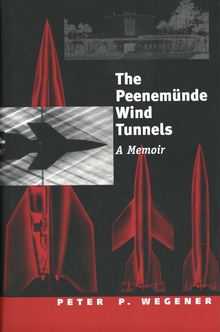The Peenemünde Wind Tunnels
WARNING
You are viewing an older version of the Yalebooks website. Please visit out new website with more updated information and a better user experience: https://www.yalebooks.com
A Memoir
Peter P. Wegener
In this fascinating book, Wegener recounts his experiences during Hitler's time, World War II, and his years at Peenemünde. He tells how he was working one night in August 1943 when the Allies bombed the laboratories, but left the wind tunnels undamaged. The tunnels were moved to Bavaria, and Wegener was ordered to follow in 1944. After the war, the tunnels were moved again—this time to the United States, accompanied by the author and other German scientists. Shortly before the end of the war, Wegener visited Germany's underground V-2 production plant to retrieve archival material on aerodynamics that had been stored in caves for safekeeping. He describes the appalling history of the concentration camps where SS guards watched over inmates who toiled underground in inhuman conditions and often did not survive. A photoessay enhances this remarkable memoir.
"This book represents an important chapter in the literature of the wartime German rocket program. Wegener's insights into technical issues, aspects of life in wartime Germany, and everyday life inside the Peenemünde research and development facility are of genuine interest and value."—Tom D. Crouch, Smithsonian Institution
"An original contribution to the history of WW II, rocket development, and space travel."—Frank E. Goddard, Jr., former assistant director, Jet Propulsion Laboratory, NASA
"This book represents an important chapter in the literature of the wartime German rocket program. Wegener's insights into technical issues, aspects of life in wartime Germany, and everyday life inside the Peenemünde research and development facility are of genuine interest and value."—Tom D. Crouch, Smithsonian Institution
"[An] absorbing memoir. . . . Informative, interesting, and useful to historians. . . . The book is also readable. It belongs on the reading list of all those interested in the history of rocketry, as well as anyone fascinated by the dilemmas of science and technology in the Third Reich."—Michael J. Neufeld, Nature
"A fascinating personal story that illuminates both the technical aspects of the V2 rocket programme, and its terrible human cost."—New Scientist
"The memoir offers valuable insights into a scientifically rich and morally dubious wartime enterprise. . . . A worthwhile addition to our understanding of the challenges—technical and moral—faced by scientists in wartime."—Choice
"Wegener describes the super- and hyper-sonic research in lay terms, his experiences in war-time Germany, the slave labor work on the V-2, SS power grabs, his move to the U.S. and work in the Navy's research lab."—Reference & Research Book News
"Highly informative, most interesting, and well-written."—Frederick I. Ordway, IEEE Spectrum
"This fascinating book with a very neutral and highly technical title wades immediately into several enormously controversial topics: the politics of high technology; the power of technological surprise; the invention and use of radar, rocket-powered guided missiles (V1 and V2 weapons), and nuclear (fission) weapons); and the extremely adverse effects of a despotic bureaucracy on novel technical development. . . . I recommend the book highly to those wanting the understand more clearly the fury of technical life during World War II."—Albert A. Mullin, Science Books and Films
"A photographic essay enhances this superb book and remarkable memoir."—British German Review
"[Wegener] has written a personal but objective account, evidently based, as far as possible, on official documents as well as on his own documents as well as on his own diary. The book is illustrated with technical and historical photographs and presents detailed notes and background information ron relevant topics, as well as a chronology of events. . . . With this book Wegener has produced a valuable and well-written document, an important addition to the literature on the subject."—Hans G. Hornung, Physics Today
"The future work of all historians of early rocketry and high speed flight will greatly benefit from Wegnere's formal compilation of recollections."—Peter L. Jakab, Technology and Culture
Publication Date: September 25, 1996
55 b/w illus.








